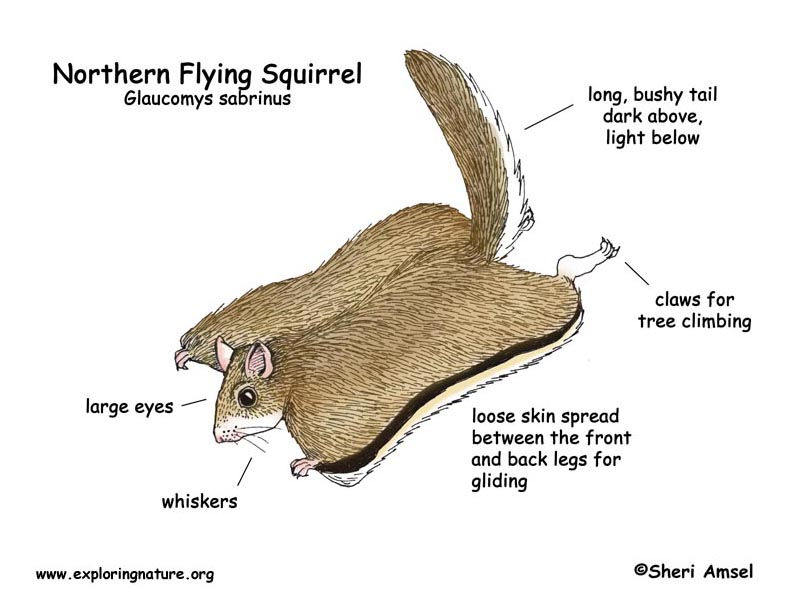

Northern flying squirrels are found in Canada, the northern United States down into the Appalachian Mountains.
They live in conifer or mixed forests.
Though they can grow to be 14-inches long, they only weigh about 5 ounces making them the smallest of all the squirrels. They are gray to brown, with a flat tail, large eyes and loose skin flaps that go from their wrists to ankle along their sides.
Flying squirrels don’t really fly, but glide with outstretched arms and legs, the flap of skin held out like a sail. In this way they can move up high in the treetops and sail 100 feet at a time if they need to. The are the only squirrel active at night (nocturnal), so few people see them gliding. They nest in trees and spend the winter in torpor. They are not true hibernators.
Flying squirrels eat nuts, berries, buds, and flowers. They may also eat insects, bird eggs, or even a bird nestling itself.
Predators include owls, hawks, martens, weasels, coyotes, and house cats.
Flying squirrels have only one mate at a time (monogamous), but may have a new mate the next year. Females are pregnant for about 40 days (gestation) and have 3-6 young.
They can live 5-6 years in the wild. They are listed as Lower Risk - least concern on the CITES List (International List) and endangered on the U.S. Federal Endangered Species List in some regions.
Kingdom: Animalia
Phylum: Chordata
Subphylum: Vertebrata
Class: Mammalia
Order: Rodentia
Suborder: Sciuromorpha
Family: Sciuridae
Subfamily: Sciurinae
Genus: Glaucomys
Species: Glaucomys sabrinus
When you research information you must cite the reference. Citing for websites is different from citing from books, magazines and periodicals. The style of citing shown here is from the MLA Style Citations (Modern Language Association).
When citing a WEBSITE the general format is as follows.
Author Last Name, First Name(s). "Title: Subtitle of Part of Web Page, if appropriate." Title: Subtitle: Section of Page if appropriate. Sponsoring/Publishing Agency, If Given. Additional significant descriptive information. Date of Electronic Publication or other Date, such as Last Updated. Day Month Year of access < URL >.
Amsel, Sheri. "Squirrel (Northern Flying)" Exploring Nature Educational Resource ©2005-2024. December 13, 2024
< http://www.exploringnature.org/db/view/Squirrel-Northern-Flying >

